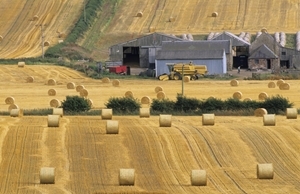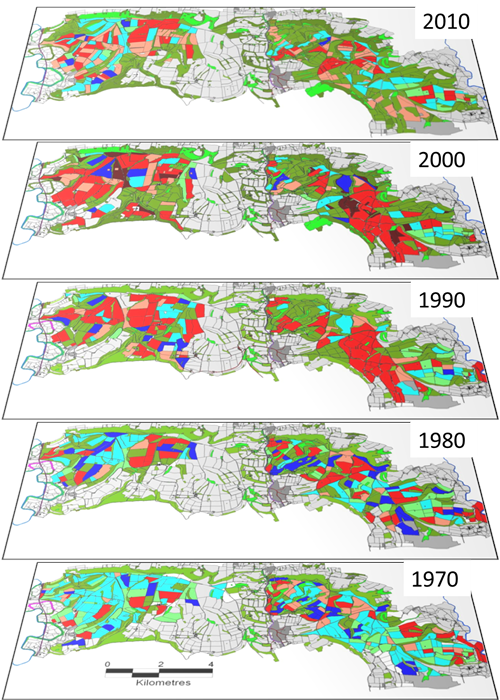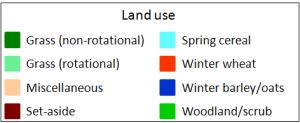 The Sussex study area is divided amongst eight farms of varying sizes, with five large farms covering the majority of the area. The GWCT monitors the changes in management that have occurred across these farms but is not involved in the decision making process, although our advisory team does provide advice if it is requested.
The Sussex study area is divided amongst eight farms of varying sizes, with five large farms covering the majority of the area. The GWCT monitors the changes in management that have occurred across these farms but is not involved in the decision making process, although our advisory team does provide advice if it is requested.
The changes in land-use that have occurred are particularly striking when displayed in map form (Figure 1). At the beginning of the study most of the farms were managed with a traditional rotation system that reflected the soil type (chalk rendzinas). In 1970, the extent of light blue reflects the fact that spring cereals, mainly barley, were the dominant cereal type in this rotation. Winter wheat (red) was unevenly distributed. Rotational grass (undersown grass leys - light green) was widespread, with four of the five large farm units managed using traditional rotations that included undersowing of cereal crops (usually spring cereals) to establish grass. Non-rotational grass (dark green) was restricted to the slopes of the Downs. Winter barley/oats (dark blue) and miscellaneous or break crops (orange) were mainly to be found in the one farm that had moved from traditional rotations to one that included mixed arable and grass (established without undersowing) and using break crops such as oilseed rape and linseed to break up the continuous sowing of cereals.
Figure 1: Changes in land use over 40 years in the Sussex Study area


By 1980, the preponderance of spring barley had been replaced with winter cereals, with three of the five large farms now abandoning traditional rotations in favour of rotations that featured arable and less grass, often not rotating at all, with any grass no longer undersown. Fields had been combined, with a loss of hedgerows and field boundaries particularly evident after Britain joined the Common Agricultural Policy (CAP) in the early 1970s.
By 1990 only one of the large farm units retained traditional rotations, with the other farm that had retained this style of management into the 1980s now following a continuous winter wheat rotation. It was also during the 1980s that the British government started to provide money through environmental stewardship schemes whose effects can be seen in the picture of land-use in 1990. Both the Countryside Stewardship Scheme and the Environmental Sensitive Area Scheme (ESA) began in the 1980s. On the Sussex study area it was the South Downs Environmental Sensitive Area Scheme that encouraged farmers to revert arable land to permanent grass. There was a resultant increase in the amount of non-rotational grass managed in big blocks, in particular on the eastern side of the study area. These large areas of grass, together with the movement to a mainly winter cereal rotation without grass leys of any type, which was possible with changes in pesticides and driven by market values, resulted in a landscape dominated by big blocks of cropping.
The introduction of set-aside in the mid-1990s had brought in some variety to the landscape but there were still large monocultures of winter cereals predominating over most of the area. Large swathes of the study area, especially the eastern side, had been taken out of cereal farming entirely. The next decade has seen further development of environmental stewardship schemes, through both the Entry and Higher Level Schemes, and the loss of set-aside. By 2010, fields had been divided where they had been combined over the past 40 years and there was a return to the planting of spring cereals with a patchwork pattern to the cropping on the western side of the study area. On the eastern part of the study area, the management on the farm that had been in a continuous winter wheat rotation had changed to a rotation that included spring cereals, with grass leys.
Further reading
- Potts, G.R. 2003. The myth of the overwintered stubble. Bird Study, 50: 91-93.
- Potts, G.R. 2002. Arable farming: The options for game and wildlife. Journal of the Royal Agricultural Society of England, 163: 72-82.
- Aebischer, N.J. & Potts, G.R. 1998. Spatial changes in Grey Partridge (Perdix perdix) distribution in relation to 25 years of changing agriculture in Sussex, UK. In: Birkan, M.G., Smith, L.M., Aebischer, N.J., Purroy, F.J. & Robertson, P.A. (eds) Perdix VII: Proceedings of the Perdix VII International Symposium on Partridges, Quails and Pheasants, Tome 1; Gibier Faune Sauvage: 293-308. Office National de la Chasse, Paris.
- Potts, G.R. 1997. Cereal farming, pesticides and grey partridges. In: Pain, D.J. & Pienkowski, M.W. (eds) Farming and Birds in Europe: 150-177. Academic Press, London.
- Potts, G.R. 1991. The environmental and ecological importance of cereal fields. In: Firbank, L.G., Carter, N., Darbyshire, J.F. & Potts, G.R. (eds) The Ecology of Temperate Cereal Fields: 3-21. Blackwell Scientific Publications, Oxford.